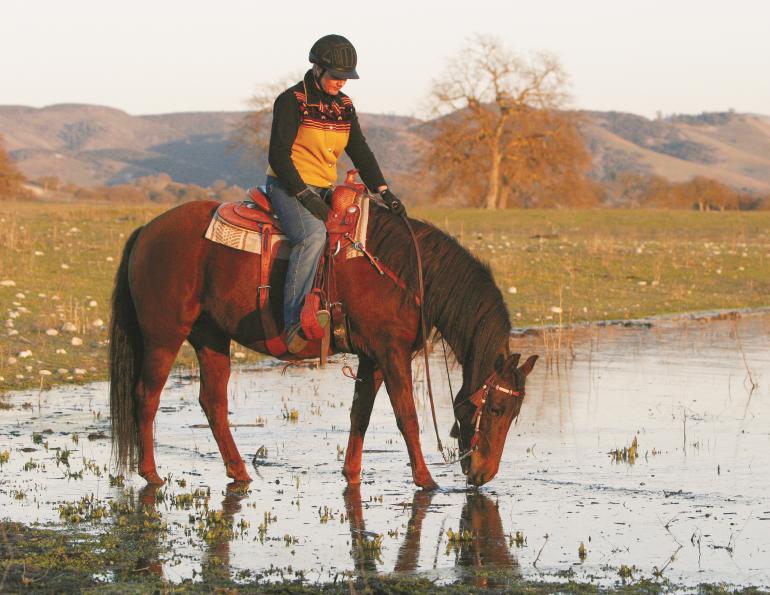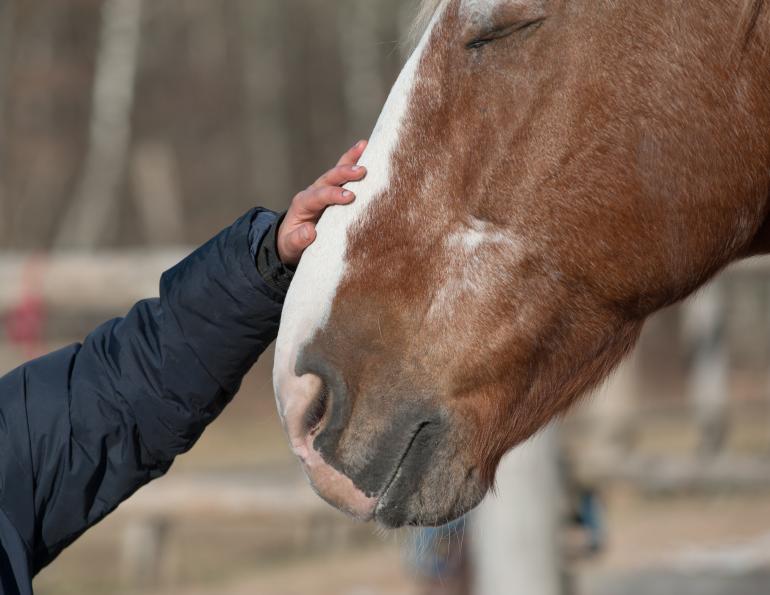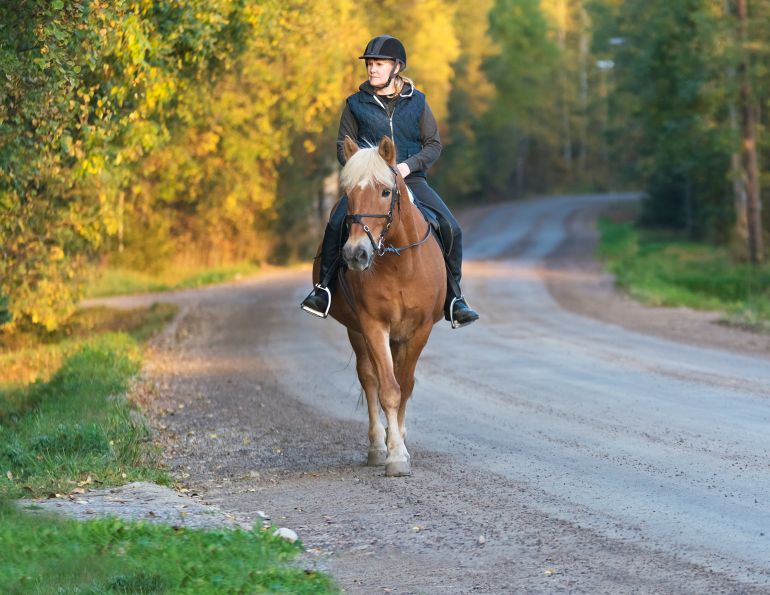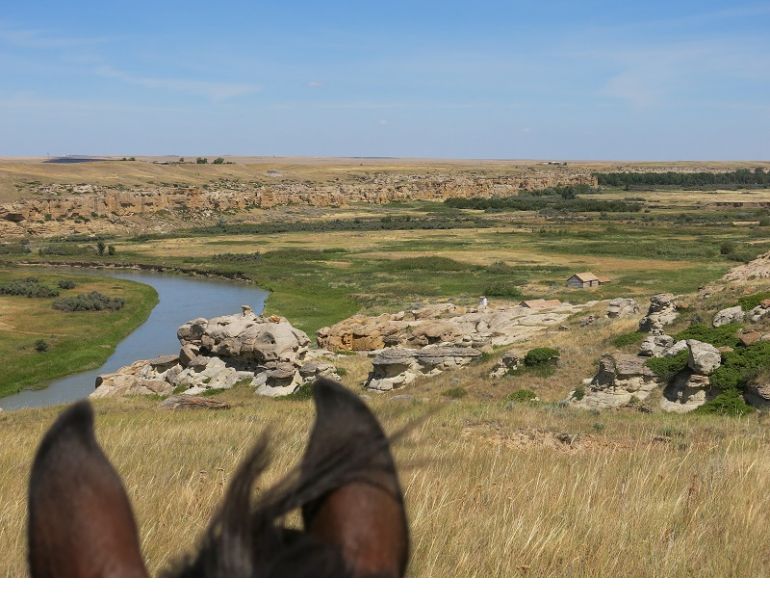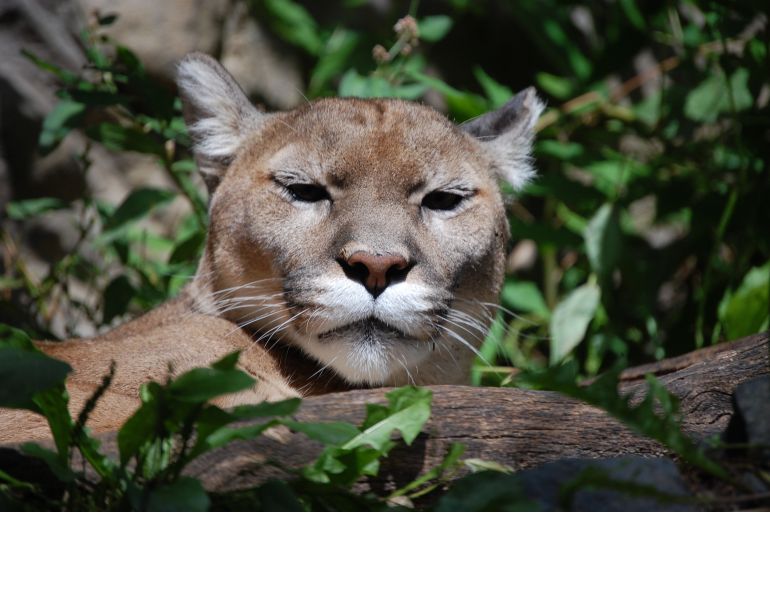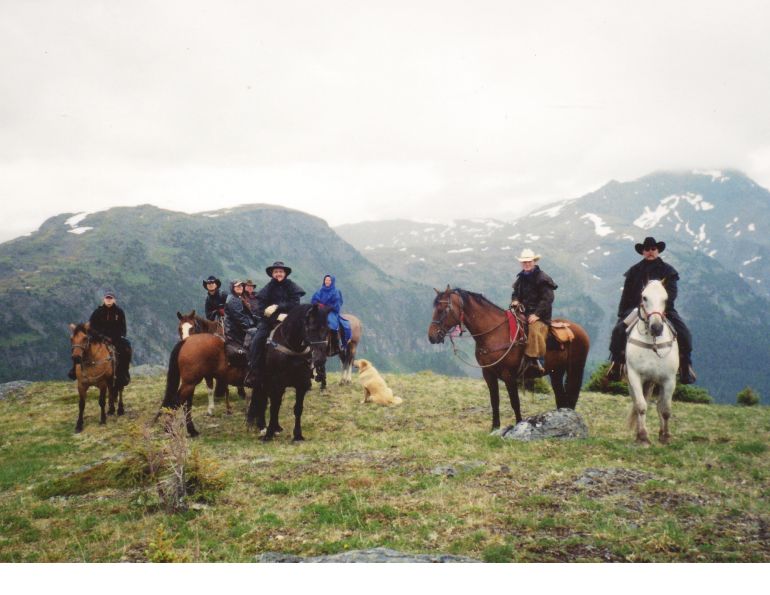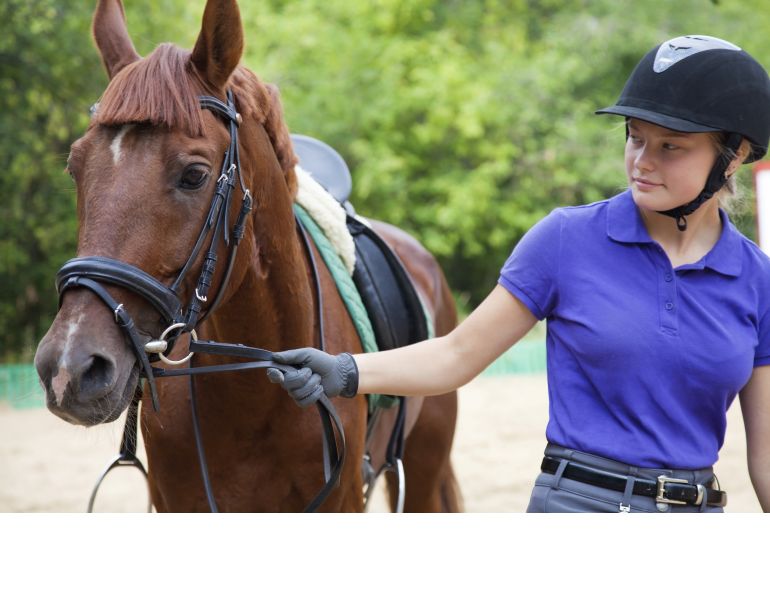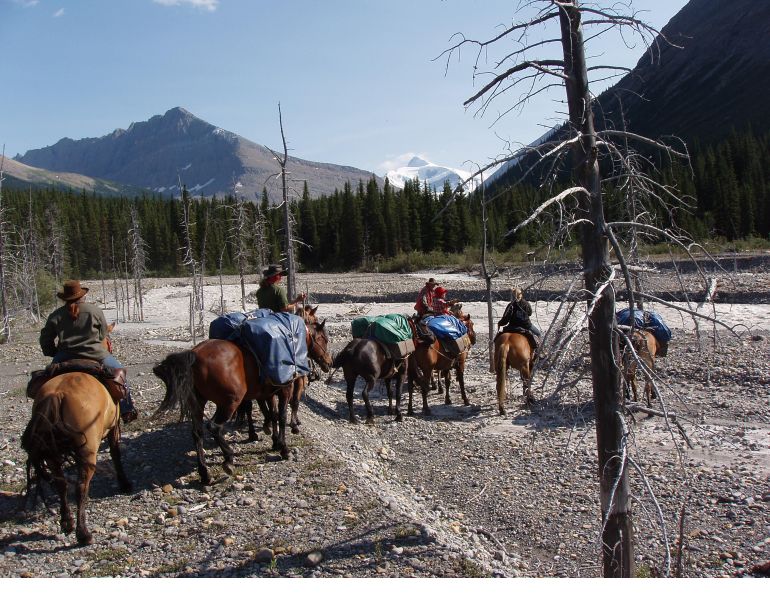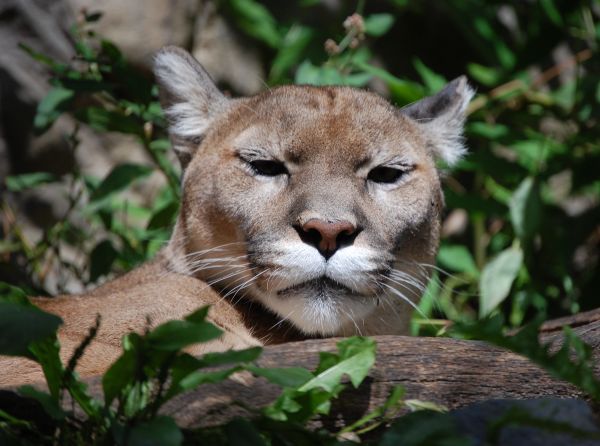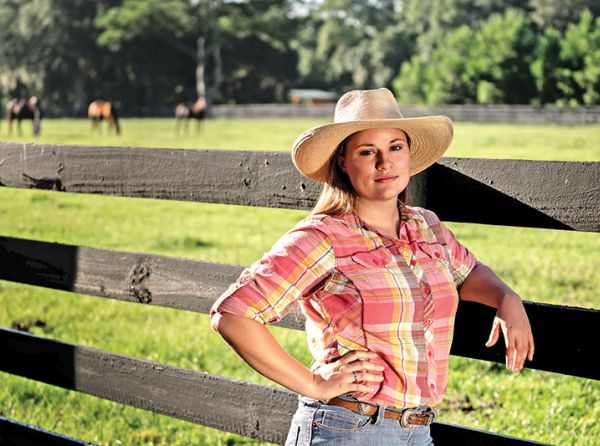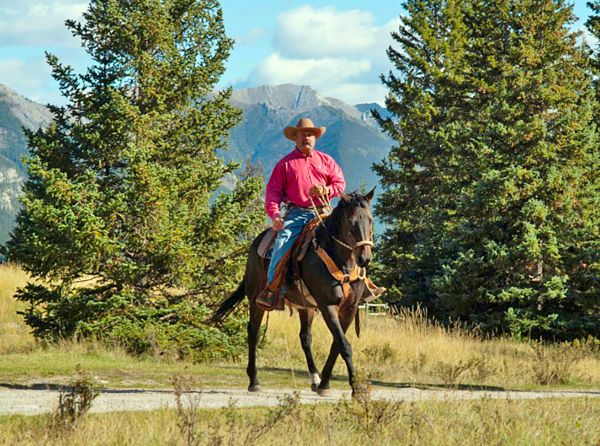By Stan Walchuk, Jr.
Life as the Blue Creek Trail Riding/Packing Clinic instructor is always interesting, never boring, and often as much a learning experience as a teaching one. The personalities of humans and horses always make for a lively program, and this was especially evident this year when some guests brought their own horses.
Mixing guests’ horses with our proven trail herd is not always a good idea. For one thing, horses can bicker as they find their places in the social order. New horses may not be calm minded and properly desensitized to trail conditions. Their body types and durability, and especially their hooves, may not be suitable for the rigours of the trail. Moreover, riders tend to worry about their own horses in the new and challenging environment, sometimes to the point where the worry takes the fun out of the adventure. Fortunately, this year the addition of guests’ horses to the mix went smoothly and I learned that a horse does not necessarily have to be the perfect trail horse for the rider to have fun.
I have always stressed the importance of good bone and solid, good-sized feet in a trail horse, so when a couple of 1200-pound Quarter Horses showed up with the large, rounded hindquarter muscle typical of the breed, and “ought” or “double-ought” sized front feet, I was understandably skeptical about their chances at a successful introduction to rocky mountain riding. But the trails were not overly taxing and, much to my delight, these horses’ minds were calm, steady, and friendly. It brought home to me an important point: The horse’s mind, disposition, and training can play the larger role in contributing to our enjoyment, provided the trails are reasonable.
One afternoon, the riders wound up a narrow skid trail headed for alpine and majestic views. Shorty, a Morgan-cross recently introduced to our herd, was being ridden by a very capable 16-year-old rider who specifically asked for Shorty because he had some extra “life.” But Shorty had the attention span of a fish and every time we stopped for a break he kept wanting to head out again and fussed at any correction to the point that on one such break, he ended up backing over the edge of the trail at a spot where it dropped down into a wooded gorge.
As Shorty’s rear quarters dropped over the bank everyone gasped, expecting the young man to go for a tumble, but in a panic the horse’s back feet scrambled and he had enough purchase to push himself and his rider back up to sure footing. Shorty is an excellent example of a horse with good trail conformation but an erratic mind; when he stepped back off the trail, I would have quickly traded his desirable conformation for a calm, forgiving mind.
When we talk about a trail horse being ready for the trail, first we need to know that his mind is ready by its nature and training, and that he has been properly desensitized. Let’s look at nine key areas we must be sure about.
1. A Guessing Mind: The trail horse needs a guessing mind. A guessing mind can be developed by using a variety of cues or pressures each time you work with your horse so he does not know what you are going to ask next. This puts you in control of the horse’s mind because he must wait for your command. With the variety of commands you keep the horse’s mind patient and expecting a variety of tasks – this is important because on the trail you meet many obstacles and give many cues. Creating a guessing mind also earns you the horse’s respect, which is critical under trail conditions.
Training for a guessing mind begins with ground work, whether it’s lunging or round pen work. The time to apply pressures or cues asking for the horse to move his body over left and right, back, turn, stop, start, or put his head down, is after join-up or exercise when the horse’s mind is soft and responsive, and you are alpha.
2. Stops and Starts: Trail horses are constantly stopping and starting because of conditions on the trail. Your horse may not always agree with the direction you choose or the obstacles you ask him to face (brush, water crossings, bogs), but he must always move out briskly on command. There is nothing more frustrating on the trail, when you need to make miles and the day is long, than a horse that dogs along or is balky when you lead.
Fix these problems beforehand on the ground with lots of brisk stops and starts while leading in hand. Always use a verbal command first before the physical cue, as the ultimate aim is for the horse to move out and stop on verbal commands alone. Do not give the horse second and third verbal commands before applying crisp physical cues. One kiss or cluck to move out and if the horse doesn’t move immediately, give him a tap with the training whip. Same with the butt rope, one verbal command and then the tug. Use the same philosophy when teaching your horse to stop – one “whoa” – and if he doesn’t respond give him a crisp bump back on the halter. The horse will soon understand that your commands to start and stop require an immediate response.
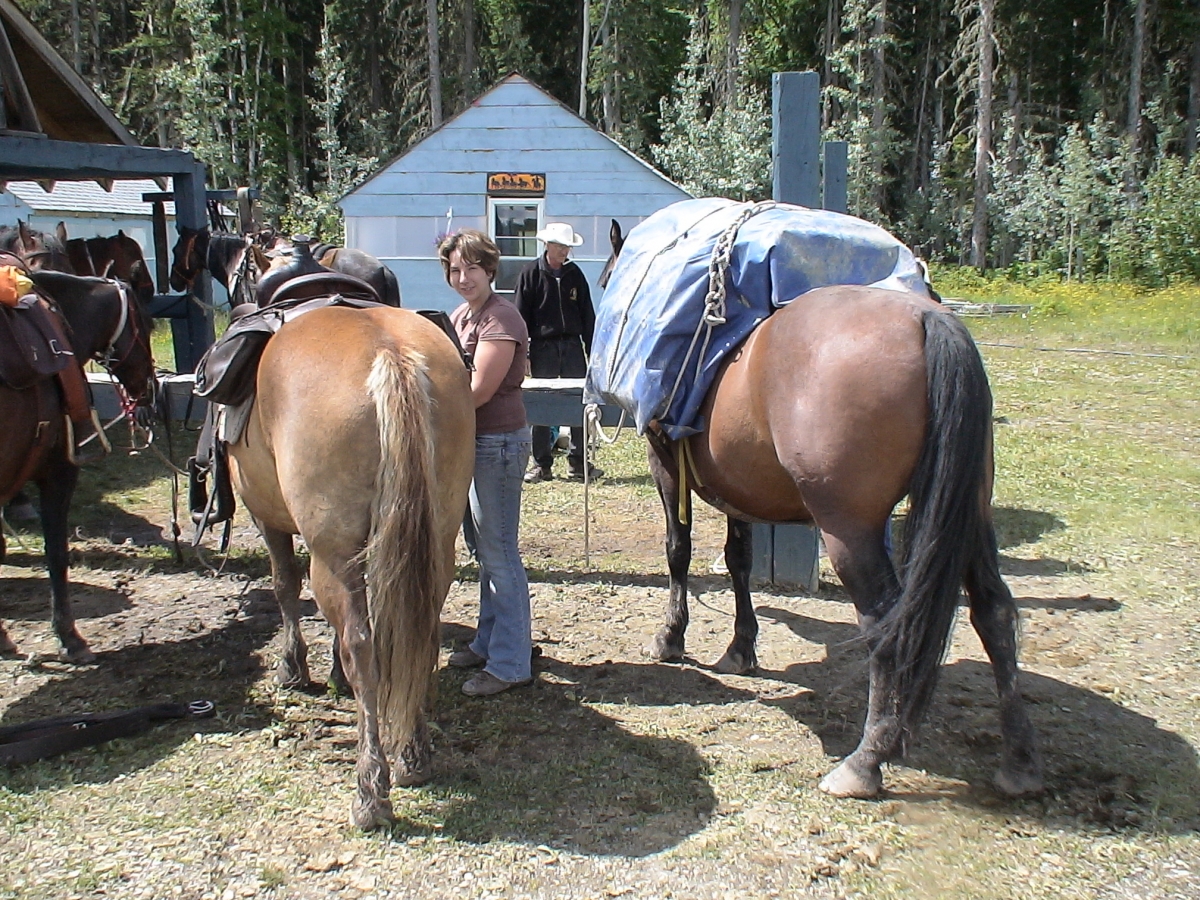
While on the trail you’ll constantly find yourself in tight spaces – between two horses, between your horse and a tree, and so on. For your safety, it is paramount that the horse respects your space and moves over when asked. Photo courtesy of Stan Walchuk, Jr.
3. Tight Spaces: While on the trail you’ll constantly find yourself in tight spaces – between two horses, between your horse and a tree, between your horse and a building or gate post, between two pack horses, and so on. For your safety, it is paramount that the horse respects your space and moves over when asked. We train a horse to move its rear quarters over when we say “over” and apply pressure by bumping or “pulsing” a thumb just behind the last rib. Nearly all of our physically applied cues are in pulses because the horse understands this type of pressure.
4. Giving to Pressure Pulses: I can remember the last battle I had with a horse while on the trail. It was a few years ago, and I was leaving the trail string and heading off in another direction to find a better route. Normally not a herd-bound horse, my mount must have been feeling mighty lonely that day because he gave me major grief as he struggled to get back to his buddies and we had an uncharacteristic battle with the reins. These tugs-of-war should be avoided like the plague and training your horse to respond to a pulsing action can help.
As the horse begins to understand the meaning of the pulses, you can reduce the intensity of each pulse, thereby building a soft mind and soft mouth. If the horse misbehaves or doesn’t respond, you can increase intensity until he gets the message, then reduce the pressure and get back to being soft in only moments.
If your riding horse is constantly pressuring the horses in front, or wants to pass them, you can pulse back with the reins to avoid a battle. Pulsing can also come in handy with the horse who wants to drift downstream during a stream or river crossing; just pulse his head back up to correct him while giving him some freedom.
5. A Calm, Forgiving Nature: With all of the surprises your trail ride can offer – vehicles, ATV’s, bikes, plastic bottles underfoot, bears, birds, ropes around legs and under tails, and rain gear flapping in the wind – your trail horse needs to be absolutely desensitized. Repetitive lessons early in a horse’s career can quickly familiarize him with these empty demons. The problem comes when your horse is nervous and spooky by nature, rather than calm and forgiving. You’ve heard the truism: There are two kinds of people in the world – those who make things better and those who make things worse. The same principle applies to horses. You know which kind of trail horse you need. Do not ruin your good time or get hurt because you fell in love with the wrong trail partner.
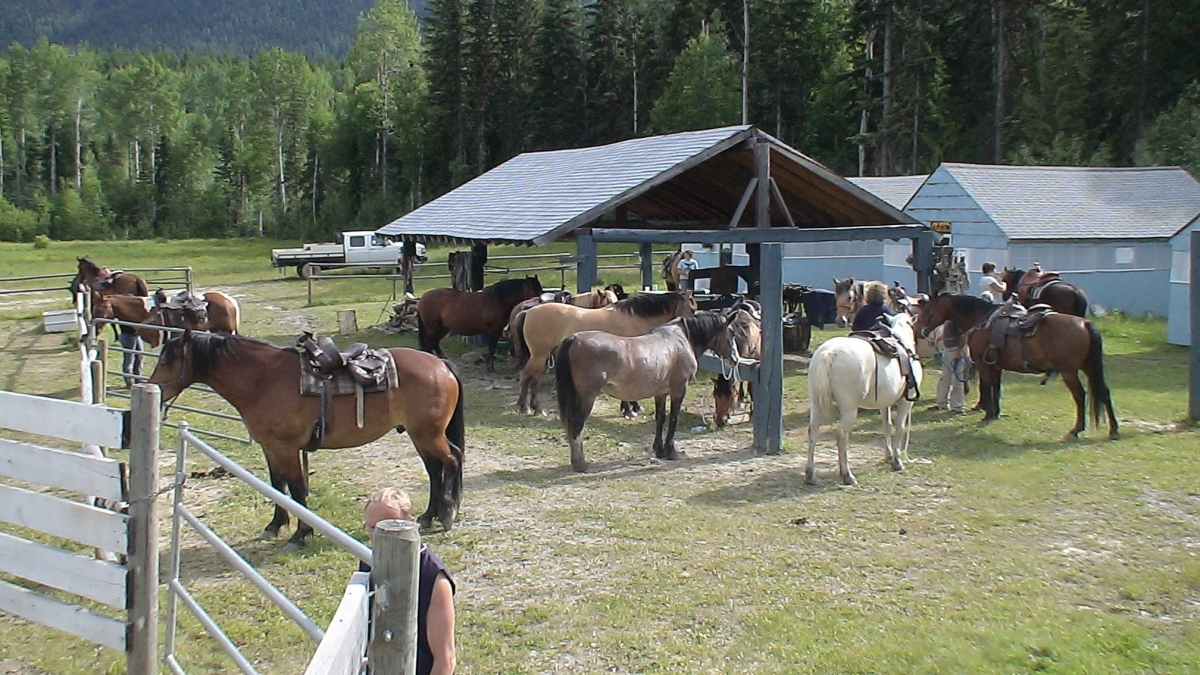
Trail horses need to stand for long period, often a few hours at a time. Train your horse to stand patiently at home before your trail ride. Photo courtesy of Stan Walchuk, Jr.
6. Standing Still: Trail horses need to learn to tie or ground-tie (to stand still when you drop the reins or lead rope and walk away). There are many occasions on the trail when you’ll have to ask your horse to stand still, such as when you’re retrieving a dropped glove or having a snack. A horse that wanders off is more than a nuisance, he can leave you stranded.
Begin training your horse to ground-tie with a lunge line or driving lines, or by simply stopping and asking the horse to stand for longer periods of time until he gets the message.
Standing patiently while tied to trees and fence posts is also good training for a trail horse because there are many times when you’ll want to go and investigate something or otherwise make a stop without keeping your horse in hand. Horses that fuss while standing will benefit from hobbles, and hobbles will also prevent damage to trees from tying. With a nervous trail horse, this training may require extra time and patience, but experienced trail horses quickly learn to appreciate standing quietly while tied because it means a break from work.
Friendly is good. Some riders do not feel that a horse does not need to be friendly to be a good trail horse, but a people-friendly horse tends to be a better companion. Photo courtesy of Stan Walchuk, Jr.
7: People-friendly: Trail horses tend to be easier to catch and better companions if they like people. Before hitting the trails, bring your horse into close quarters and repeatedly go into his space offering affection until he begins to look forward to your company. Giving some treats is acceptable while building this friendly relationship but do not go overboard and spoil the horse into thinking it is okay to come into your space without being asked. Placing a shy horse in hobbles will often encourage him to stand quietly while you approach and to accept your presence.
8. Bush-savvy: Your trail horse must be comfortable walking through brush and mud, stepping over logs and debris, and getting slapped with branches (just like you will). Lazy horses typically get their legs scratched, bumped, and bruised far more than bush-savvy horses. Horses raised in this environment are well ahead of the game so if your horse is stabled or kept in a clean field, he will be at a disadvantage. If you have the opportunity, turn your horse out in brushy, variable terrain to help prepare him.
9. Conformation: We must consider the importance of a horse’s body type when determining if he is ready for the trail. Admittedly, a good mind is crucial when it comes to enjoying a safe, fun trail experience, but your horse’s body type should also be appropriate. This includes having good withers and being of suitable height, but for the most part you shouldn’t expect too much from a horse that does not have adequate foot, bone, or strength.
Many inexperienced horse owners are genuinely unsure of how much their horse can handle, what he may be capable of, or what his shortcomings may be. If your horse has a thin, soft hoof wall, even if he is shod, the shoe will generally come off sooner under trail conditions which will leave you and your horse in a serious bind if you are out in the woods.
Trail work is pounding exercise and horses that have been bred for colour, movement, or conformation for performance disciplines may not have the durability in their feet and legs to take the punishment. These horses may end up with laminitis, navicular, or other soundness problems. By comparison, horses with tougher, larger bone – for example, draft or draft cross lines – are more likely to give you years of service with few, if any, issues.
I hope this article helps you develop a suitable, trail-savvy horse so that you and your equine partner can better enjoy your trail rides. It’s a big, bushy world out there and I wish you many years of trail adventure!
To read more by Stan Walchuk on this site, click here.



